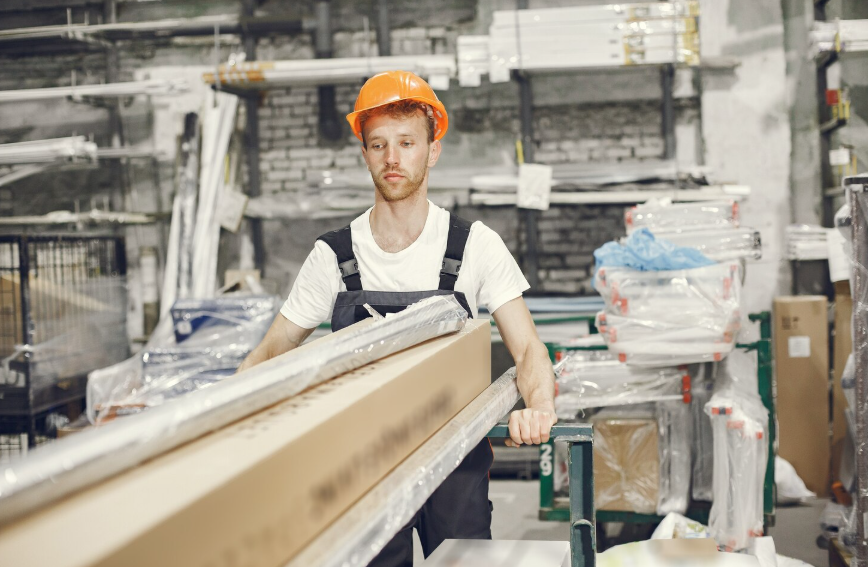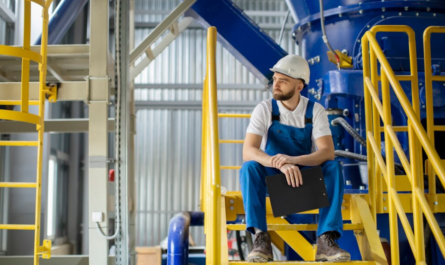Introduction
Have you ever wondered why some workplaces feel more comfortable, productive, and safe than others? The secret often lies in ergonomic design. When a plant (factory, manufacturing unit, or industrial site) is designed with ergonomics in mind, workers are not only safer but also more efficient, motivated, and less prone to injuries.
In this blog, we’ll dive deep into the factors of ergonomic design of a plant—covering everything from workplace layout and lighting to seating and material handling. Whether you are a safety professional, plant manager, or business owner, understanding these factors can transform your workplace into a safer, healthier, and more productive environment.
What is Ergonomic Design in a Plant?
In simple terms, ergonomic design means designing workstations, equipment, and processes to fit the capabilities and limitations of workers. Instead of forcing workers to adapt to the machine or environment, ergonomics ensures that the workplace adapts to the worker.
Poor ergonomic design often leads to musculoskeletal disorders (MSDs), fatigue, reduced efficiency, and even serious injuries. On the other hand, a well-designed plant enhances safety, comfort, productivity, and morale.
Key Factors of Ergonomic Design in a Plant
Let’s break down the core factors you should consider when designing or improving the ergonomics of a plant:
1. Plant Layout and Workstation Design
The layout of a plant is the foundation of ergonomics. A poorly planned layout can result in unnecessary movements, wasted time, and higher risks of injury.
✅ Best Practices:
- Place frequently used equipment and tools within easy reach.
- Ensure proper spacing between machines to reduce crowding.
- Keep pathways clear to minimize tripping hazards.
- Arrange workstations in a logical sequence to reduce unnecessary handling.
A streamlined layout not only improves safety but also enhances workflow efficiency.
2. Posture and Body Mechanics
Workers often spend long hours in repetitive tasks. Poor posture caused by bad workstation design leads to back pain, neck strain, and repetitive stress injuries.
✅ Ergonomic Considerations:
- Adjustable chairs and work tables for both sitting and standing tasks.
- Proper height for machines and conveyors to avoid bending or overreaching.
- Encourage neutral postures where joints are naturally aligned.
- Anti-fatigue mats for standing jobs to reduce strain on legs and back.
Pro Tip: Always design equipment and stations for the average worker, but provide adjustments for variations in height and strength.
3. Lighting and Visibility
Lighting has a direct impact on productivity and safety. Poor lighting causes eye strain, fatigue, and errors in work.
✅ Best Practices:
- Ensure uniform lighting across the plant to avoid glare and shadows.
- Use task lighting for detailed work like inspections or assembly.
- Incorporate natural lighting where possible to boost worker morale.
- Maintain emergency lighting in critical areas.
Good lighting reduces accidents and ensures workers can perform tasks accurately without strain.
4. Noise Control
Noise is one of the most overlooked ergonomic hazards in plants. Prolonged exposure leads to hearing loss, stress, and reduced concentration.
✅ Solutions for Noise Ergonomics:
- Use noise-dampening materials and barriers around loud machines.
- Provide hearing protection such as earplugs or earmuffs.
- Rotate workers to minimize continuous exposure to noisy environments.
- Conduct regular noise level monitoring.
A quieter workplace keeps workers focused, reduces fatigue, and improves overall well-being.
5. Temperature and Ventilation
A comfortable thermal environment is critical for worker performance. Excessive heat, cold, or poor ventilation can cause discomfort, fatigue, and even health risks.
✅ Ergonomic Considerations:
- Maintain workplace temperatures within comfortable ranges (20–26°C).
- Use fans, ventilation systems, or air conditioning where necessary.
- Provide protective clothing in extreme weather conditions.
- Ensure proper air circulation to avoid stuffiness or accumulation of harmful gases.
Good ventilation improves not only comfort but also air quality, which directly impacts worker health.
6. Material Handling and Lifting
Manual handling is one of the biggest causes of workplace injuries. Poor ergonomics in material handling leads to back injuries, strains, and repetitive motion injuries.
✅ Best Practices:
- Provide mechanical aids such as hoists, conveyors, and forklifts.
- Train workers in safe lifting techniques (bend knees, not the back).
- Design loads with handles and manageable weights.
- Reduce the need for twisting, bending, or carrying heavy loads over long distances.
Automation and assistive tools are excellent investments to reduce strain on workers.
7. Seating and Standing Workstations
Both sitting and standing jobs have their risks. Long hours of sitting cause lower back pain, while prolonged standing leads to leg and foot problems.
✅ Ergonomic Adjustments:
- Provide adjustable chairs with lumbar support.
- Encourage alternating between sitting and standing.
- Supply footrests and anti-fatigue mats.
- Ensure workstations allow proper posture regardless of sitting or standing.
A balance of movement throughout the workday is the key to reducing fatigue.
8. Tools and Equipment Design
The design of tools and equipment plays a vital role in reducing strain and improving efficiency.
✅ Ergonomic Tool Design:
- Use tools with padded, non-slip handles.
- Ensure tools are lightweight and reduce vibration.
- Provide power tools for repetitive tasks.
- Design handles and grips that fit naturally into the worker’s hand.
Small improvements in tool design can drastically reduce the risk of repetitive strain injuries.
9. Work Organization and Task Design
Ergonomics is not only about physical design—it’s also about how work is structured.
✅ Key Elements:
- Avoid monotonous, repetitive tasks by introducing job rotation.
- Allow sufficient rest breaks to prevent fatigue.
- Balance workload to avoid mental and physical overload.
- Provide training to workers on ergonomic practices.
A well-organized job design enhances both efficiency and worker satisfaction.
10. Safety Signage and Communication
Ergonomics also involves ensuring workers can quickly and clearly understand safety instructions.
✅ Best Practices:
- Use clear, visible, and well-placed safety signs.
- Incorporate color codes for hazards (red for danger, yellow for caution, green for safety).
- Use multilingual signage in diverse workforces.
- Ensure alarms and signals are distinguishable and not overwhelming.
Clear communication prevents accidents and enhances the safety culture of the plant.
11. Human-Machine Interface (HMI)
Modern plants rely heavily on automation and digital control systems. Designing human-machine interfaces ergonomically is crucial.
✅ Considerations for HMI Design:
- Keep controls and displays within easy reach and line of sight.
- Use intuitive layouts for buttons, switches, and screens.
- Provide feedback signals to confirm operator actions.
- Avoid cluttered or overly complex interfaces.
Good HMI design reduces errors, enhances productivity, and ensures safer operations.
12. Psychological and Cognitive Ergonomics
While physical ergonomics is often emphasized, mental workload is equally important. Stress, fatigue, and poor work culture affect safety.
✅ Ways to Improve Cognitive Ergonomics:
- Reduce information overload by simplifying tasks.
- Provide training and clear standard operating procedures (SOPs).
- Encourage teamwork and communication.
- Support mental health programs and counseling.
A psychologically supportive environment boosts morale and reduces errors caused by stress.
Benefits of Ergonomic Design in a Plant
When plants adopt ergonomic principles, they reap multiple benefits:
- ✅ Reduced workplace injuries and accidents
- ✅ Lower absenteeism and turnover
- ✅ Increased worker productivity and efficiency
- ✅ Improved morale and job satisfaction
- ✅ Cost savings in compensation claims and downtime
- ✅ Enhanced overall safety culture
Real-Life Example: Ergonomics in Action
Consider a manufacturing plant where workers had to bend frequently to pick parts from bins. This led to back pain and absenteeism. By simply redesigning the workstation—raising the bins to waist height and providing lifting aids—the company reduced back injuries by 60% and improved production speed.
This shows how small ergonomic improvements can make a big difference.
Conclusion
Designing a plant with ergonomics in mind is not just about comfort—it’s about safety, efficiency, and sustainability. By addressing factors such as layout, posture, lighting, noise, ventilation, material handling, and cognitive ergonomics, organizations can create workplaces where people thrive.
Remember, a safe worker is a productive worker, and ergonomic design is one of the smartest investments any plant can make.
Did you find these ergonomic design factors useful? Share your thoughts in the comments below and let us know what ergonomic practices your workplace follows!
👉 For more detailed safety blogs and workplace improvement tips, don’t forget to subscribe to our blog.
🔁 Readers also enjoyed these blog posts:
- Safety Management’s Role: The Unsung Hero Behind Every Successful Organization
- Safety Management and Its Responsibilities: Protecting People, Preventing Hazards, and Promoting a Culture of Care
- Benchmarking for Safety Performance: A Key to Continuous Improvement
“Start Your Website Journey Today – Exclusive Hostinger Discounts!”

Turn Any Idea into Viral,
Jaw-Dropping AI Videos in Seconds!










